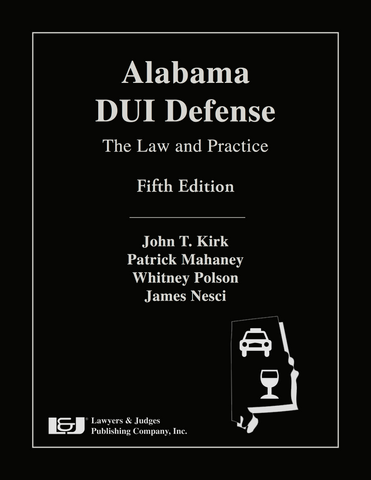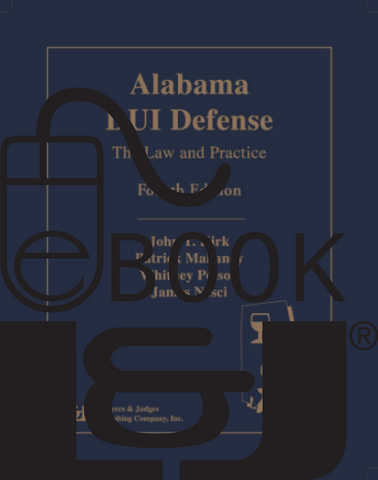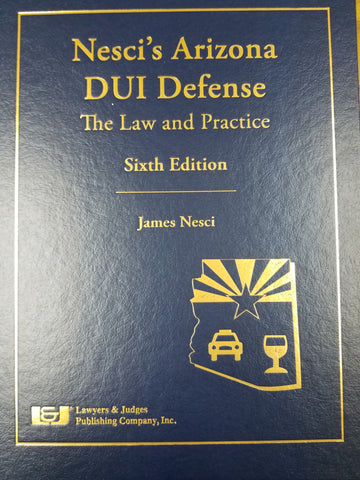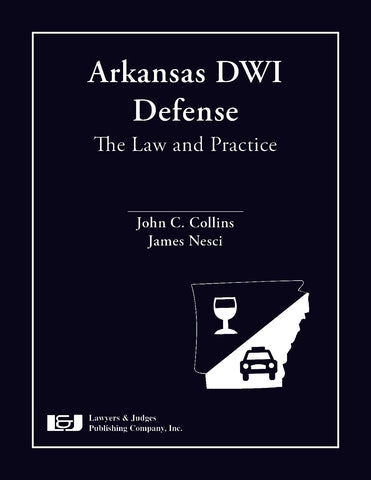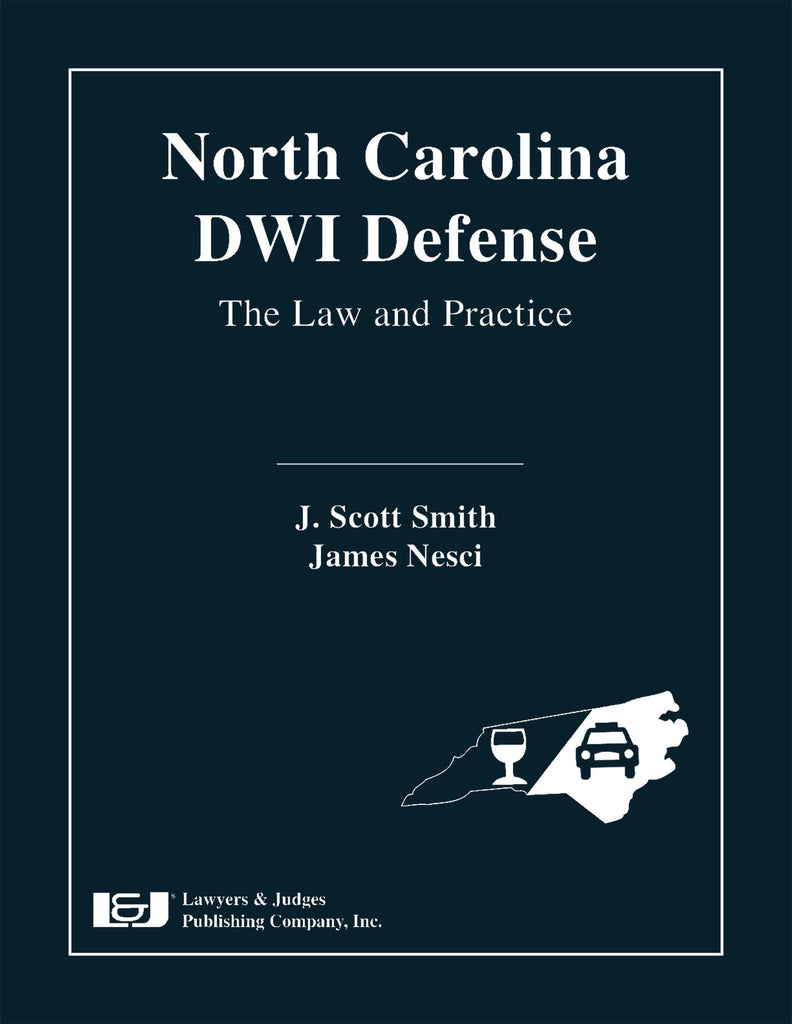
North Carolina DWI Defense: The Law & Practice with DVD
-
Author: J. Scott Smith, James Nesci
- ISBN 10: 1-936360-37-3
-
ISBN 13: 978-1-936360-37-6
-
Copyright Date Ed: December 14, 2015
-
Pages: 448
-
Binding Information: Casebound with DVD
- Size: 8.5 ✕ 11 Inches (US)
For even the most seasoned attorney admitted to practice in the State of North Carolina, defending DWI cases has always presented special challenges. Today mounting a successful defense is more difficult than ever. Now you have the advantage with North Carolina DWI Defense: The Law and Practice. This text and supplementary DVD contains the most important information to help you attain a successful verdict.
Written by J. Scott Smith and James Nesci, both members of the National College for DUI Defense, North Carolina DWI Defense: The Law and Practice ensures that you understand the chemical, biological and technological concepts and issues underlying DWI prosecution and defense in the State of North Carolina. The authors provide the most up-to-date information available on key areas of DWI law in North Carolina including: DWI Investigations, Driving and Field Sobriety Testing, Drug Recognition, Evaluation and Chemical Testing, Blood Alcohol Calculations, Pre-trial Investigations and Motions, Practice, Plea Offers and Agreements, DWI Trial Procedures, and more.
Many practical tools and applications designed to streamline and simplify the complex DWI defense process have been developed along with this book. They are all included on a bonus DVD--so you can locate, review and print them out in a matter of seconds. The companion DVD contains NHTSA studies, articles and visual detection videos.
Lawyers & Judges has published twenty state-specific DUI defense reference books. A practitioner in Colorado raved in the Colorado Lawyer that Colorado DUI Defense: The Law and Practice is “a must-have resource” and would make “a nice gift for the lawyers in your life who practice DUI defense.” The Wisconsin Lawyer reviewer gave Wisconsin OWI Defense: The Law and Practice a touchdown review, calling the book “the best book I have read pertaining to Wisconsin operating-while-intoxicated (OWI) law, and one of the best in dealing with the substance of OWI law.”
Book Topics Include:
- Chapter 1: Lawyer Advertising
- Chapter 2: Client Relations
- Chapter 3: Driving Under the Influence
- Chapter 4: Division of Motor Vehicles
- Chapter 5: Pre-Trial Investigations
- Chapter 6: Pre-Trial Motions Practice
- Chapter 7: Plea Offers
- Chapter 8: Trial
- Chapter 9: DWI Investigations: Driving and Field Sobriety Testing
- Chapter 10: Drug Recognition Evaluation
- Chapter 11: Chemical Testing
- Chapter 12: Blood Alcohol Calculations for Attorneys
- Chapter 13: Expert Witnesses
- Chapter 14: DWI Jury Trial Warpack
- Appendix A: North Carolina Rules of Evidence
- Appendix B: North Carolina Rules of Criminal Procedure
- Appendix C: North Carolina Department of Public Safety Alcohol Testing
- Appendix D: The Aging Process and Field Sobriety Tests by Mimi Coffey, Esq.
- Appendix E: DWI-Modern Day Salem Witch Hunts by Mimi Coffey, Esq.
- Appendix F: DWI-Fear and the DWI Field Sobriety Tests by Mimi Coffey, Esq.
- Appendix G: North Carolina Pattern Jury Instructions for Criminal Cases from the UNSC School of Government
DVD topics include:
- NHTSA Advanced Roadside Impaired Driving Enforcement (ARIDE) Manuals 2013
- Automobile & Motorcyclist Pamphlets
- NHTSA Drug Recognition Expert Course (DRE) 7-Day School 2013
- NHTSA Improved Sobriety Testing
- NHTSA DWI Detection and Standardized Field Sobriety Testing
- Standardized Field Sobriety Testing Validation Studies
- And more!
Table of Contents
Tables of Cases
Preface
Chapter 1: Lawyer Advertising
1.1 Ethical Issues in Advertising
Rule 7.1 Communications concerning a lawyer’s services
Rule 7.2 Advertising
Rule 7.3 Direct contact with potential clients
Rule 7.4 Communication of fields of practice and specialization
Rule 7.5 Firm names and letterheads
1.2 Advertising Resources
A. Phone Book Advertising
B. Internet Advertising
C. Giveaways
1.3 Social Media
A. Ethical Concerns
B. Confidentiality vs. Privilege
C. The 3 Tenets of Social Media: Timeliness, Honesty, and Transparency
D. Facebook
E. Twitter
F. Social Media as a Research Tool
G. Final Thoughts on Social Media
Endnotes
Chapter 2: Client Relations
2.1 Meeting the Prospective Client
2.2 Client Intake Questions
2.3 Client Intake Interview
2.4 Retainer Agreements
2.5 Fees
2.6 IOLTA
2.7 Communication
2.8 Client File Retention
Chapter 3: Driving While Impaired
3.1 Misdemeanor DWI: Many Changes
N.C.G.S. §20-4.01–Definitions
Date of offense
N.C.G.S. §20-138–Misdemeanor DWI
3.2 DWI Sentencing and Punishment
Aider and Abettor Punishment
3.3 Impaired Driving in other vehicles
3.4 Underage Impaired Driving
3.5 Habitual DWI (Felony DWI)
3.6 Homicide
3.7 Reckless Driving
3.8 Boating While Impaired
3.9 Other related charges
3.10 Seizure and Forfeiture of a Motor Vehicle
Chapter 4: Division of Motor Vehicles
4.1 Overview
4.2 The Role of the Magistrate
4.3 Civil Revocations
4.4 The Pre-arrest Test
4.5 Implied Consent to Chemical Analysis
4.6 Chemical Analysis Procedures
4.7 Affidavits, Revocation Reports, and Procedures
4.8 Fighting the Civil Revocation
4.9 Refusal Revocations
4.10 Driving Privileges
4.11 Driver’s License Restoration and Alcohol Restrictions
4.12 Ignition Interlock Requirements and Restrictions
4.13 Suspension for Out-Of-State Convictions
4.14 Validity of Out-of-State Licenses
4.15 Out-of-State Licensees
4.16 DMV Driver Points System
4.17 Commercial Driver’s License Disqualifications
4.18 Commercial Driver’s License Notification Requirements
4.19 Expungement of Motor Vehicle Record (MVR)
Chapter 5: Pre-Trial Investigations
5.1 Overview
5.2 Proper Filing Techniques
5.3 Visiting the Scene
5.4 Photography and Videos
5.5 Diagrams and Aerial Photography
5.6 Accident Reconstruction
5.7 Event Data Recorders (Black Boxes)
5.8 Roadblock (a.k.a. “DWI Checkpoint”) Investigations
5.9 Pre-Trial Interviews, Law Enforcement
5.10 Pre-Trial Interviews, Emergency Personnel
5.11 Pre-Trial Interviews, Civilians
5.12 Prior Offenses
Chapter 6: Pre-Trial Motions Practice
6.1 Overview
6.2 Procedural Motions
6.3 Substantive Motions
6.4 Motions in Limine
6.5 Evidentiary Hearings
Chapter 7: Plea Offers
7.1 Overview
7.2 Waiver of Rights
7.3 Collateral Consequences
7.4 Immigration Consequences
7.5 Exposure of Prior Offenses
7.6 Subsequent Offenses
7.7 Out of State, Timing and Juvenile Prior Offenses
7.8 Misdemeanor Plea Offers
7.9 Felony Plea Offers
Chapter 8: Trial
8.1 Overview
8.2 Voir Dire and Jury Selection
8.3 Jury Instructions
8.4 Opening Statements
8.5 Cross-Examination
8.6 Direct Examination
8.7 Closing Argument
8.8 Sentencing
Chapter 9: DWI Investigations: Driving and Field Sobriety Testing
9.1 Overview: National Highway Traffic Safety Administration (NHTSA)
9.2 Driving Behavior
9.3 Standardized Field Sobriety Testing (SFST) Validation Studies
9.4 Legal Analysis and Summary of the SFST Validation Studies
9.5 Standardized Field Sobriety Test Battery
9.6 Horizontal Gaze Nystagmus (HGN)
9.7 Walk and Turn
9.8 One-Leg-Stand
9.9 Correlation Between BAC and HGN or FSTs
9.10 Refusal of SFSTs and General Admissibility
9.11 Commonly Used Non-Standardized/Non-Validated Field Sobriety Tests
9.12 Videotaping the Driving and Investigation
References
Chapter 10: Drug Recognition Evaluation
10.1 Overview
10.2 DRE Statutory Law
10.3 Per Se Statutes Comparison
10.4 Impairment Statutes Comparison
10.5 Defenses
10.6 Implied Consent Laws Comparison
10.7 DRE Case Law
10.8 The 12-Step DRE Protocol
10.9 Deconstruction and Analysis of the 12-Step DRE Protocol
10.10 Effects of Various Drugs
10.11 Drug Evaluation Classification Protocol (DECP)
10.12 Drug Evaluation Classification Training Program
Chapter 11: Chemical Testing
11.1 Preliminary Breath Testing
11.2 Law
11.3 Safeguards
11.4 Commonly Used PBT Devices
11.5 Henry’s Law and the Blood-to-Breath Ratio
11.6 Evidential Breath Testing
11.7 Infrared Light Absorption
11.8 Principles and Theory of Dry Gas Standards
11.9 Gas Tank Instrument Errors
11.10 Principles of Fuel Cell Sensor
11.11 Principles of Infrared Cell
11.12 General Operating Principles
11.13 Interferents
11.14 The Operating Environment
11.15 North Carolina Operating Procedures
11.16 Operator Instrument Messages
11.17 Maintenance
11.18 Breath Testing: Methods of Attack
11.19 Calibration
11.20 North Carolina Administrative Code on Breath Testing
11.21 Blood Testing: From the Vein to the Lab
11.22 Headspace Gas Chromatography
11.23 Breath, Blood, and Urine tests: Statutory Admissibility
11.24 Uncertainty of Measurement
11.25 Blood Testing for Drugs
11.26 Secondary Blood Testing
References
Chapter 12: Blood Alcohol Calculations for Attorneys
12.1 Blood Alcohol Calculations for Attorneys
12.2 Determining the One-Drink Potential
12.3 Elimination and Retrograde Extrapolation
12.4 White’s Retrograde Extrapolation
12.5 Partition Ratio Conversions
12.6 Unit Conversions
Chapter 13: Expert Witnesses
13.1 Overview
13.2 Pretrial Preparation
13.3 Direct Examination of the Defense Expert Witness
13.4 Cross of the State’s Expert Witness
13.5 Direct Examination of the State’s Expert as a Defense Witness
Chapter 14: DWI Jury Trial Warpack
14.1 Actual Physical Control (APC)
14.2 Aggravation
14.3 Appellate Standard of Review
14.4 Arrest
14.5 Authentication
14.6 Blood Draws
14.7 Breath Testing
14.8 Burden of Proof
14.9 Chain of Custody
14.10 Circumstantial Evidence
14.11 Closing Arguments—Ethical Considerations
14.12 Collateral Estoppel in DWI Cases
14.13 Comment of Defendant’s Silence
14.14 Confrontation
14.15 Corpus
14.16 Court Rules
14.17 Credibility of Witnesses
14.18 Destruction of Evidence
14.19 Discovery
14.20 Motions to Dismiss/Motions for a Directed Verdict of Not Guilty
14.21 Double Jeopardy
14.22 DRE: Drug Recognition Evaluation Admissibility
14.23 Due Process
14.24 Evidence
14.25 Expert Witnesses
14.26 Field Sobriety Test Admissibility
14.27 Foundation
14.28 HGN
14.29 Impeachment
14.30 Independent Test
14.31 Jurors and Jury Selection
14.32 Jury Deliberations
14.33 Jury Instructions
14.34 Jury Trial Right
14.35 Motions
14.36 Miranda
14.37 Necessity Defense
14.38 DMV
14.39 Opinion Testimony
14.40 Plea Agreements
14.41 Prior Convictions
14.42 Probable Cause
14.43 Reasonable Suspicion
14.44 Record Preservation for Appeal
14.45 Refusal to Submit to Chemical Testing
14.46 Relation Back
14.47 Replicate Testing
14.48 Restitution
14.49 Right to Counsel
14.50 Roadblocks (a.k.a. “DWI Checkpoints”)
14.52 Searches
14.53 Sentencing
14.54 Subpoena
14.55 Voir dire
14.56 Voluntariness of Statements
14.57 Warrants
Appendix A: North Carolina Rules of Evidence
Appendix B: North Carolina Rules of Criminal Procedure
Appendix C: North Carolina Department of Public Safety Alcohol Testing
Appendix D: The Aging Process and Field Sobriety Tests
by Mimi Coffey, Esq.
Appendix E: DWI—Modern Day Salem Witch Hunts
by Mimi Coffey, Esq.
Appendix F: DWI—Fear and the DWI Field Sobriety Tests
by Mimi Coffey, Esq.
Appendix G: North Carolina Pattern Jury Instructions for Criminal Cases
UNC School of Government
About the Author
Index

